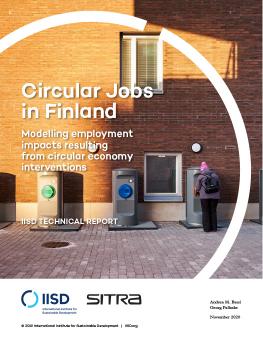
Circular Jobs in Finland
Modelling employment impacts resulting from circular economy interventions
The Circular Economy (CE) assessment explores the outcomes of implementing CE interventions for selected products and sectors in Finland. The areas analyzed include consumer electronics and appliances, textiles, food, mining and scrap metals, forestry and paper production, and buildings. A dynamic simulation model was developed and calibrated to the Finnish context for each of these areas.
Overall, positive employment impacts are forecast for the consumer electronics and forestry sectors, mainly emerging from the high labour intensity of collection, recycling and refurbishing activities. Buildings show net employment creation in the short term, and declines in the medium and longer terms. Negative employment impacts are forecast for all other sectors, largely due to the high contribution of upstream activities to total employment, in the form of primary production of materials (e.g., food, metal ores, textiles), and a reduction of retail jobs resulting from a higher lifetime of products.
Related models are available for download, which can be viewed using software available through Vensim:
- Electronics (.mdl)
- Food (.mdl)
- Forestry (.mdl)
- Mining (.mdl)
- Textiles (.mdl)
Participating experts
You might also be interested in
State of the Sector: Critical energy transition minerals for India
This report presents a comprehensive strategy for securing a reliable supply of critical energy transition materials (CETMs) essential to India's clean energy and low-carbon technology initiatives.
Unlocking Supply Chains for Localizing Electric Vehicle Battery Production in India
This study aims to highlight the key supply chain barriers in localizing electric vehicle (EV) battery cell manufacturing in India. It summarizes consultations with 12 companies, as well as experts and policy-makers, to determine the crucial challenges and opportunities in localizing battery manufacturing in India.
Securing India's Copper Supply
This policy brief emphasizes the need for India to develop a comprehensive copper strategy.
IISD Joins Global Battery Alliance
IISD is pleased to announce that it has joined the Global Battery Alliance (GBA) as a non-profit member. The GBA is a public–private collaboration platform founded in 2017 at the World Economic Forum to help establish a sustainable battery value chain by 2030.